“PGS: Intuition is Your Personal Guidance System” (2017). Cast: Bill Bennett, Caroline Myss, James Van Praagh, Dr. Dean Radin, Dr. Norman Shealy, Dr. Judith Orloff, Lee Carroll, Dr. Rita Louise, Dr. Jeffrey Fannin, Michael Tamura, Paul Selig, Dr. Francesca McCartney, H.H. Pujya Swami Chidanand Saraswati, Sadhvi Bhagawati Saraswati, Foster Gamble, Kimberly Carter Gamble, Hansaji Jayadeva Yogendra, Zeyno Baran Bryza, Amanda Guggenheimer, His Royal Highness Prince Jigyel Ugyen Wangchuck. Director: Bill Bennett. Screenplay: Bill Bennett. Web site. Trailer.
Many of us have a vague idea of what constitutes what we call our “intuition,” that nebulous sense of “knowing” that ultimately proves to be uncannily on target, despite not fully understanding where the information it imparts comes from. To complicate matters, the contents of intuitive messages seldom seem based in logic, making the information’s validity seemingly suspect. But, despite its mysterious origins and the apparent red flags often raised with it, does this mean we should automatically dismiss the intuition as something unreliable and untrustworthy? Its track record would seem to suggest otherwise. So what are we to do? Perhaps taking a closer look at our intuition would give us a better understanding of what it is and how it functions, the objective of the excellent new documentary, “PGS: Intuition is Your Personal Guidance System.”
While on a trip to the US, veteran Australian journalist and filmmaker Bill Bennett was driving to the airport, somewhat pressed for time. As he approached an intersection, he heard a voice that told him to slow down, a suggestion that he contends he typically would have ignored under such circumstances. But, for whatever reason, this time he decided to heed the recommendation. And it’s a good thing he did: As he arrived at the intersection, an enormous speeding semi truck ran a red light at the cross street. Had Bennett continued as he had been going, he surely would have been seriously injured, if not killed, in a horrific crash.
Paying attention to “that little voice in his head,” that “gut feeling,” saved his life. He was so profoundly impacted by the incident that he began obsessing about what happened. He became consumed about trying to determine where that seemingly illogical but life-saving information came from and why it came to him when it did. He soon realized that this compulsion would not leave him alone until he did something about it. And it was from that experience that he began a three-year exploration into examining and understanding the nature of intuition, a journey that led to the creation of this film.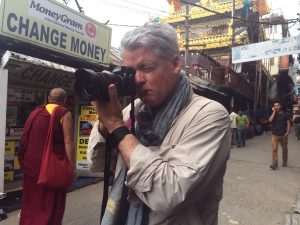 Filmmaker Bill Bennett on location in the making of his new documentary release, “PGS: Intuition is Your Personal Guidance System.”[/caption]
Filmmaker Bill Bennett on location in the making of his new documentary release, “PGS: Intuition is Your Personal Guidance System.”[/caption]
As a longtime journalist used to ferreting out the truth by gathering cold, hard facts, Bennett knew that, in the course of his investigation, he would likely come up against material that didn’t readily fit his typical approach. He therefore realized that, if he were to succeed at this task, he would have to consciously set aside that preconception and keep an open mind about what he might encounter. And, based on some of the interviews he would conduct for the film, it’s apparent that some of the information he uncovered was likely far different from what he was accustomed to encountering through the kinds of stories he more typically researched. To his credit, though, Bennett stuck to his guns and put his journalistic assumptions aside as he proceeded, leaving himself open to whatever came his way.
In making the film, Bennett traveled the globe, visiting places as far flung as his native Australia, the US, India, Turkey and places in between. He interviewed a variety of experts from a range of fields, including those from “traditional” backgrounds, like science and medicine, to those more versed in the unconventional, like psychics, channelers and spiritual healers, as well as those from a variety of religious orientations. Through these conversations, the experts provide different pieces of the intuition puzzle, but, amazingly, their observations all fit together, creating a mosaic of insights, giving viewers a comprehensive picture of what constitutes this phenomenon.
Most of the film’s segments open with a question, such as “How Do I Tap Into It?” and “What Stops It?” From there, Bennett explores each question and presents comments from experts for elaboration, explanation and examples. This provides viewers with an easy-to-understand format that, collectively, paints a concise yet inclusive picture of what the intuition is, how it works and why it’s important. This is especially true when it comes to understanding how we can make use of it to better our lives. Effectively drawing on the power of this personal guidance system can be employed in countless ways, from seizing upon valuable opportunities to recognizing fortuitous synchronicities to, as Bennett found out for himself, saving your life.
Intuition is particularly valuable for the role it plays in the conscious creation process, the philosophy that maintains we manifest the existence we experience through the power of our thoughts, beliefs and intents. Its importance lies in its contribution to the formation of our beliefs, which, in turn, provide the basis for our reality’s manifestation. Along with intellect, with which most of us are already well (if not obsessively) acquainted, intuition provides input into shaping the intents we employ to materialize the world around us in all its myriad aspects.
Unfortunately, we often tend to downplay the validity and significance of intuition in this process. That’s primarily because it’s seen as illogical and irrational, making it appear – falsely – that it’s fundamentally less reliable. It seems to lack the “certainty” we associate with the intellect, which is generally given a free pass when it comes to belief formation. But such an approach is shortsighted, mainly because it’s incomplete. Without the input of the intuition, we may miss essential nuances that are critical to making our beliefs work. Intuition frequently fills in important gaps in our thinking, providing details that might be otherwise overlooked but must be addressed as part of the belief development and reality creation processes. The result could easily be disappointment, frequently accompanied by a sense of not knowing what went wrong.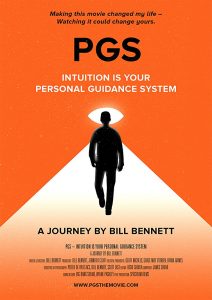
Taking steps to hone our intuition, then, would be a wise course in becoming more proficient conscious creators. Many of the experts in the film recommend starting out with small steps; after all, if we’re not practiced at making use of our intuition, it’s unrealistic to expect that we can go from a standing start to cruising speed in a single leap, especially in our initial attempts. In this regard, making use of our intuition is comparable to exercising a muscle; if that muscle hasn’t been used in a while (or ever), it’s unlikely that it will be able to perform feats of magnificent strength straight out of the box without an opportunity to be sufficiently built up. With regular practice, however, a sense of comfort and confidence will grow that will enable us to use our intuition more effectively, consequently making it possible to employ it in forming better-targeted beliefs and more satisfying manifestations. (Not a bad deal for a little effort on our part.)
One expert recommends the oft-cited example of using our intuition to find a parking space in a crowded city neighborhood. Many people who don’t claim to make ready use of their intuition nevertheless invariably insist that they instinctively know how to locate these elusive spaces, despite the odds of their availability seemingly being heavily stacked against their discovery. Even though these individuals don’t attribute their success to effective use of their intuition, that’s precisely what they’re doing when they engage in such exercises. Applying this protocol to other applications, preferably of comparable magnitude, can help intuition initiates become more practiced in their skills and aid them seeing how it can be used for a wider range of uses than simply finding parking spaces.
If this is all so seemingly easy, however, why don’t we do it more readily? As noted previously, in large part, it’s due to our intuition being viewed as unreliable and untrustworthy. But what specifically drives those feelings? In most instances, it comes down to a question of fear. A number of the film’s experts cite this as something that holds us back from trying new things, particularly those that are unknown and untried and fall within the realms of uncharted territory. In many regards, that aptly defines how many of us tend to view our intuition. It’s not perceived as being as clear cut and seemingly verifiable as the way the intellect operates, so that in itself makes it something worthy of skepticism and caution.
However, while the experts understand that this is a natural reaction, they also advise that it’s an ill-considered viewpoint. They contend that intuition is infallible, that it never steers us wrong, that it always leads us to where we’re supposed to be. In fact, they caution, the only times we get ourselves into trouble come when we purposely ignore it, a practice we engage in at our peril. Thankfully, this is something that becomes more apparent the more we learn to trust – and follow – what our intuition tells us. And, once we have that down, there’s no telling what we can do with it.
In compiling this film, Bennett has assembled an impressive lineup of experts, including author and medical intuitive Caroline Myss, holistic medical practitioner Dr. Norman Shealy, after-death medium James Van Praagh, psychiatrist and author Dr. Judith Orloff, and Institute of Noetic Sciences chief scientist Dr. Dean Radin. (Biographies of these and many other experts can be found on the Interviews page on the film’s web site.) In addition, Bennett does an excellent job of framing his film’s subject matter, placing it in a clear, readily accessible format, one that leaves few stones unturned in explaining what the intuition is all about. It provides both an informative and personal take on the material, bringing it down to a level that audiences can more readily relate to. Overall, it’s the kind of film that aspiring directors of metaphysical documentaries could learn a lot from.
“PGS” is currently playing at special screenings in the US, the UK, Australia and New Zealand. For dates and details, check out the film’s web site. To find out how to set up a screening in the US, click here. A companion book to the film is also currently in development.
There’s no doubt that the intuition exists and that it can be a valuable life tool. And now, thanks to this film, there’s a great resource for understanding how it works. The information it contains may prove invaluable whenever we approach life’s intersections, be they figurative or literal.
Note: Join host Frankie Picasso and yours truly for an upcoming special edition of Frankiesense & More in which we’ll interview Bill Bennett about his new release. We’ll speak with the director about the making of this wonderful new documentary, as well as what makes the intuition so special. Watch for details about its availability on the web site of The Good Media Network.
Copyright © 2018, by Brent Marchant. All rights reserved.
Wednesday, June 27, 2018
‘PGS’ explores the power – and value – of intuition
Tuesday, June 26, 2018
‘Await Further Instructions’ cautions us about what we create
“Await Further Instructions” (2018). Cast: Sam Gittins, Neerja Naik, Grant Masters, Abigail Cruttenden, Holly Weston, Kris Saddler, David Bradley. Director: Johnny Kevorkian. Screenplay: Gavin Williams. Web site. Facebook Page.
We all like to think we’re masters of our own destiny. But are we? It’s really quite astonishing how readily many of us will capitulate when faced with the pressures placed on us by those in positions of authority. So how do we cope? That’s the central question raised in the thrilling new smart horror flick, “Await Further Instructions.”
Christmas is supposed to be a festive time of year, full of good times and good cheer, especially in the company of loved ones. As many of us know, however, that’s not always the case, especially when we spend time with family members. So it is with the Milgrams, who are getting together as a group for the first time in years – not that everyone wants that, though.
The family member dreading the occasion the most is Nick (Sam Gittins), a twenty-something young man who’s seeing his relatives for the first time after a prolonged estrangement. He’s bringing his Indian girlfriend, Annji (Neerja Naik), with him in hopes that her presence will make the experience more bearable. However, given the less-than-veiled prejudicial attitudes of Nick’s other family members, such as his insincerely effusive mum, Beth (Abigail Cruttenden), his dimwitted pregnant sister, Kate (Holly Weston), and his perpetually surly granddad (David Bailey), perhaps asking Annji to join him wasn’t the best idea. Then there’s Nick’s dad, Tony (Grant Masters), a self-important, hardline Christian fundamentalist with a Napoleonic complex, an overcompensating trait designed to conceal his nagging insecurity at never having made more of himself (a fact that granddad continually goads him about). Rounding out the festivities is Kate’s husband, Scott (Kris Saddler), an often-clueless sort who seems to have ample trouble thinking for himself. And so, set against this backdrop, the fun and games begin. But, before long, the Milgram family finds itself in the midst of a holiday get-together they never would have imagined. The Milgram family (from left, David Bradley, Neerja Naik, Kris Saddler, Grant Masters, Holly Weston, Abigail Cruttenden) assembles for Christmas dinner amidst trying circumstances in the chilling new smart horror film, “Await Further Instructions.” Photo courtesy of Goldfinch Studios and Shudder Films.[/caption]
The Milgram family (from left, David Bradley, Neerja Naik, Kris Saddler, Grant Masters, Holly Weston, Abigail Cruttenden) assembles for Christmas dinner amidst trying circumstances in the chilling new smart horror film, “Await Further Instructions.” Photo courtesy of Goldfinch Studios and Shudder Films.[/caption]
As festivities ramp up, the family members witness a series of troubling TV news reports about power outages, suspected terrorist attacks and other strange phenomena. But that’s nothing compared to what they wake up to on Christmas morning. The Milgrams find their home completely encased in a durable black, strand-like substance. They have no view of the outside world through windows or doors. And though they still have electricity, they don’t have phone, cable TV or internet service. Their only connection to what’s beyond their walls is a cryptic message on their TV screen, presumably sent on a special government emergency frequency, that reads “Stay indoors. Await further instructions.” So now what?
In no time, those further instructions begin coming through, each one more ominous than what preceded it. Without giving too much away, those messages ask the family members to perform progressively more demanding tasks, some of which prompt them into taking drastic actions and questioning the home’s fellow inhabitants. Paranoia quickly sets in, and danger comes as much from the inside as it apparently does from the outside. Such circumstances raise the question, “Can they survive the holidays?” That’s something many of us do already, but this time the stakes are much higher.
As the story plays out, the Milgrams are forced into dealing with some heady questions: Is it indeed acceptable to question authority, be it from government, organized religion, the medical community and even the media? When is it permissible to cast aside the dictates of such sources and think for oneself? What does it mean to question one’s peers, including those we think we know and love? How do we keep prejudices from getting the better of us and dividing us? And what do we do if we work up the nerve to pursue our own beliefs? Even though these notions are presented in a horror film context, it’s easy to see how these considerations are just as applicable to the conditions of everyday life that we all face today – and potentially just as troubling. Nick Milgram (Scott Gittins, right) and his girlfriend, Annji (Neerja Naik, left), hold on for dear life in director Johnny Kevorkian’s excellent new smart horror film, “Await Further Instructions.” Photo courtesy of Goldfinch Studios and Shudder Films.[/caption]
Nick Milgram (Scott Gittins, right) and his girlfriend, Annji (Neerja Naik, left), hold on for dear life in director Johnny Kevorkian’s excellent new smart horror film, “Await Further Instructions.” Photo courtesy of Goldfinch Studios and Shudder Films.[/caption]
The film also raises numerous questions about technology and the media. How much faith should we place in them? When do we cross a line where we allow them to control us rather than the other way around? And can we always trust what these devices and outlets are telling us? While these ideas are presented largely symbolically, they’re nevertheless easy to spot and definitely represent concerns that we must all contend with – perhaps more than we feel comfortable with, too.
Of course, the big question here is why is this all happening? How did the Milgrams find themselves in these circumstances? For better or worse, they’re the product of the conscious creation process, the means by which we manifest the reality we experience through the power of our thoughts, beliefs and intents. And, as much as the characters here would likely want to proclaim themselves victims, that’s something that deserves a closer look.
In our technologically advanced world, we no doubt want to proudly claim credit for the many tremendous accomplishments we’ve achieved in this area. Who would have thought, even as recently as 15 years ago, for example, that we would have been able to create what we have. But, in manifesting those mechanical marvels, we must be prepared to accept the fact that we’ve created everything that goes along with them, benefits and downsides alike. The same is true of our institutions, be they in government, religion, medicine and the media. The beliefs and intents that we collectively employed to produce these items and conventions brought us all of the applications associated with them, including those that may unfortunately trap us through the works that spring forth from our own hands – and minds.
So, when we witness these things starting to go haywire by becoming more intrusive, more demanding and more worrisome, we’re just as much behind those potentially negative developments as we are behind all of the positive functions they afford us, even if most of us dislike them or are unaware of these occurrences as such. On some level, we’ve allowed their existence, and, when they come into full materialization, we may face consequences that are dire and unanticipated, despite being backed by metaphysical building blocks that brought them into being. Indeed, if we try to protest these developments and claim no responsibility for them, we nevertheless must avow our involvement in these matters, regardless of how unpleasant they are and how much we try to deny our participation.
This begs the question, then, how do we get ourselves out of such circumstances? Well, there are a number of ways to counteract these conditions. For starters, we could do like Nick and Annji and deliberately think for ourselves, making our thoughts known, even if they go against convention and what authoritarian sources have to say. We could try pushing the limits of our beliefs and intents by infusing them with qualities that purposely screen out the undesired traits. We could even try conceiving of alternate scenarios in which we devise manifestations that counter those that are causing trouble in the first place.
The bottom line here is that we’re not permanently saddled with these circumstances unless we choose to be. And that’s the challenge faced by the characters in this film and in the real world at large today. If we purposely allow ourselves to tune out to the point where these influences can have their way in shaping our existence, then we’re surely doomed. We must consciously choose for our reality to materialize otherwise. If we don’t, we may well face a future not unlike what the Milgrams experience. Is that something we really want? If not, we’d better heed the cautionary tale served up by this film – before it’s too late.
It may take a little effort to find “Await Further Instructions” at present. I screened its world premiere at the Cinepocalypse Film Festival at Chicago’s Music Box Theater, and, for the near future, it’s slated to play only at other such events. However, according to the filmmakers in a post-screening Q&A session, distribution agreements appear to be in the works, with a possible release date of this fall. When the film receives the green light, I strongly recommend that interested viewers go see it. It’s that good.
[caption id="attachment_9999" align="aligncenter" width="225"] Chicago’s Music Box Theater, home of the Cinepocalypse Film Festival, which recently featured the world premiere of the new smart horror film, “Await Further Instructions.” Photos by Brent Marchant.[/caption]
Chicago’s Music Box Theater, home of the Cinepocalypse Film Festival, which recently featured the world premiere of the new smart horror film, “Await Further Instructions.” Photos by Brent Marchant.[/caption]
Director Johnny Kevorkian and screenwriter Gavin Williams have put together an excellent production, yet another fine offering in the smart horror genre. “Await Further Instructions” combines poignant social commentary, ample humor and plenty of suspense, all without going over the top and descending into an endless gore fest, a combination that made “Get Out” (2017) such a huge hit. There’s much to ponder, a lot to laugh at and chills aplenty in this riveting, richly layered British offering, with influences from such diverse sources as Japanese cinema, classic horror films, Alfred Hitchcock and even TV’s “Twilight Zone” (particularly classic episodes like “The Shelter” and “The Monsters Are Due on Maple Street”). It packs quite a punch, one that will leave viewers with much to discuss when they walk out of the theater.
In an age where many of us may feel like we’re losing ourselves, it’s important that we have films like “Await Further Instructions” to remind us of our humanity – and the need to hold on to it at all costs. Should we ever lose sight of that – and there’s a frighteningly increased risk of that these days – we could find ourselves in perilous circumstances from which there would be no recovery. Consider ourselves warned.
Copyright © 2018, by Brent Marchant. All rights reserved.
Monday, June 25, 2018
This Week in Movies with Meaning
Reviews of "Hearts Beat Loud" and "Await Further Instructions," as well as a book award preview, are all in the latest Movies with Meaning post on the web site of The Good Media Network, available by clicking here.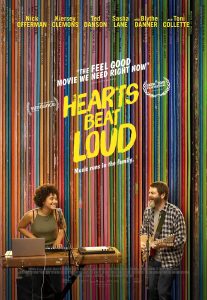




Thursday, June 21, 2018
‘Thoreau’ explores the life examined
“Henry David Thoreau: Surveyor of the Soul.” Director: Huey (a.k.a. James Coleman). Screenplay: Huey (a.k.a. James Coleman). Web site. Trailer.
Exploring the nature of our life is one of the noblest pursuits in which we can engage, and writer-philosopher Henry David Thoreau (1817-1862) was undeniably one of the best seekers ever to have undertaken this endeavor. As a result of his experiences, he wrote a variety of works covering a range of subjects. But, while the name is a familiar one, many of us are unable to describe his work or ideas with specificity. Thankfully, that shortfall has now been addressed in great detail in the excellent new documentary, “Henry David Thoreau: Surveyor of the Soul,” available for viewing on DVD and at special public screenings.
Born in Concord, Massachusetts, site of the first battle of the American Revolution, Thoreau seemed to have drawn from the revolutionary spirit of his birthplace throughout his life. The alternative views that infused his writings, philosophies, life choices and vocational pursuits set him apart from most of his peers at the time. But that’s no surprise, given that he was possessed of a natural curiosity and a desire to examine himself and his existence with a conscious deliberation that few exercise during their lifetimes.
Considering the diversity of pursuits that characterized his life, it’s difficult to pin down Thoreau to any one particular outlook or accomplishment. He invented technology to make pencil manufacturing more efficient. He was an educator who took an unconventional approach to teaching. He was a naturalist whose observational studies would prove valuable to latter-day scientists studying climate change. He wrote a variety of books and essays covering a wide range of topics. And, as this film’s subtitle implies, he was an expert land surveyor. But, as should be obvious from these and other endeavors, he surveyed more than just topography; he truly was a surveyor of the soul. Henry David Thoreau (1817-1862).
Henry David Thoreau (1817-1862).
Thoreau’s best-known experiment in personal introspection came in 1845, when he moved into the woods not far from his home. On July 4 of that year, he embarked on an ironically timed odyssey of personal independence, building a one-room cabin for himself on the shores of Walden Pond. His intent was to spend time making a concerted effort examining what it meant to live life in the moment and exactly who he was as an individual. The result of this two-year venture was Walden: Life in the Woods, arguably Thoreau’s most famous book.
Through his time at Walden Pond, a variety of travels, and the ordinary and extraordinary events of everyday life, Thoreau amassed a wide range of experiences that went into his writings. Over a comparatively short career, he compiled a thoughtful, impressive, eclectic body of work covering a variety of subjects ranging from transcendental philosophy to nature studies to social commentary and even travelogues.
But, despite the diversity of this subject matter, Thoreau often found ways to connect his topics. Understanding this inherent sense of connectedness was important to him, and he frequently sought to address various aspects of it through his work, most notably our connection to ourselves, our connection to nature, and our connection to our society and culture. As a corollary to this, Thoreau also believed it was important that we appreciate and make proper use of the resources afforded by man, nature and technology. He believed there was an intrinsic integration among these elements and that it was in our best interests to understand the nature of these interconnected relationships.
One reason why Thoreau believed that understanding these connections is important is his contention that our thoughts and existence fundamentally mirror one another. It’s an idea, for example, reflected in his work as a surveyor, an outward vocational representation of the “work” he did internally as a surveyor of the soul. Similar parallels can be found in his other writings, particularly his travelogues, which often show connections between what he witnessed and what he was experiencing personally at the time.
As an individual who was part of a larger society, Thoreau also believed it was crucial that we understand our connection to and role in that greater whole. This fueled his social activism efforts, particularly those as an ardent abolitionist. He was so fervent in his beliefs on this subject that some even considered him a radical. However, given his prevailing philosophical and metaphysical outlooks, he could not stand back in good conscience and condone a practice that he saw as a fundamental affront against humanity.
Various aspects of Thoreau’s life also reflected another innate quality – his willingness to go beyond conventional limitations and think outside the box. This thinking can be seen in activities as diverse as his abolitionist activism – far from a widely embraced outlook at the time – to the development of his improved pencil manufacturing technology. It’s also a central theme in his writing, something that genuinely set him apart from many others at the time.
From the foregoing, it’s obvious that many aspects of Thoreau’s thinking are embodiments of conscious creation philosophy, the doctrine that maintains we manifest the reality we experience through the power of our thoughts, beliefs and intents. Connectedness, surpassing limitations and seeing our external world as a reflection of our internal reality, for instance, are all concepts that feed into both Thoreau’s outlooks and the driving principles of conscious creation. It’s unlikely he ever heard of this philosophy, but, from what he thought and wrote, it’s apparent that he understood, practiced and believed in the validity and viability of its basic tenets. Had he lived a century later, he might well have become a master practitioner at it. Conscious creators who have never read his works or studied his life could significantly augment their understanding of this practice from his example, potentially learning much from one of the uncelebrated forerunners of this philosophy. Thoreau’s Walden Pond cabin site and memorial rock cairn. Photo courtesy of Films by Huey.
Thoreau’s Walden Pond cabin site and memorial rock cairn. Photo courtesy of Films by Huey.
“Surveyor of the Soul” does an excellent job of profiling its central figure, providing great detail about Thoreau’s life and work, intertwined with thoughtful examinations of his philosophy and outlooks. The film fittingly shows how his life events inspired the writings that came out of them, again drawing upon the sense of inherent connection that was such an important theme in his writing and thinking. Intercut with this narrative are additional insights drawn from interviews with authors, historians, professors, Thoreau scholars and staff from the Walden legacy sites. In addition, the film includes commentary from those who have been inspired by Thoreau, including students who participate in educational programs based on his works and philosophy. In all, director Huey (a.k.a. James Coleman) has compiled a fascinating, comprehensive piece that could easily be considered the quintessential Thoreau biography. For those who want to know more about the enigmatic author, this is definitely the film to see.
Socrates famously observed that “the unexamined life is not worth living,” a contention with which many of us would probably agree. But this need not be the case; with a little effort and guidance, it’s possible to conduct such an introspective review, and the advice Thoreau offered in this regard is as good a starting point as any. “Surveyor of the Soul” makes this process even easier, offering viewers an inclusive overview, one that can help the curious successfully launch their forays into the life examined. And, given what might come out of such an undertaking, it’s a pretty safe bet that Thoreau would likely approve.
Copyright @ 2018, by Brent Marchant. All rights reserved.
‘Hearts Beat Loud’ joyfully celebrates creativity, choice
“Hearts Beat Loud” (2018). Cast: Nick Offerman, Kiersey Clemons, Ted Danson, Blythe Danner, Toni Collette, Sasha Lane, Quincy Dunn-Baker. Director: Brett Haley. Screenplay: Brett Haley and Marc Basch. Web site. Trailer.
Following our passion is something most of us dream about. But how many of us are able to see it through? Unfortunately, life often seems to get in the way. And sometimes we get in our own way, too. Clearing away the clutter, making a plan and working up the gumption to move forward all factor into the process, but how adept are we at these tasks? These are some of the challenges that a pair of would-be professional musicians face in the heartfelt new comedy-drama, “Hearts Beat Loud.”
Frank Fisher (Nick Offerman) is restless. A onetime musician who’s now approaching middle age, Frank spends his days running a vintage vinyl store in the Red Hook section of Brooklyn, a business that’s slowly going under, something that he’s not entirely sorry to see. While Frank definitely possesses an encyclopedic knowledge about records of every stripe, he nevertheless itches to make music of his own again. Thankfully, he’s got an outlet for that with his teenage daughter, Sam (Kiersey Clemons), a bright, talented musician in her own right. Like a kid on Christmas morning, he gleefully looks forward to their jam sessions together.
But, despite the joy and fulfillment these sessions provide, as soon as they’re over, Frank quickly feels the weight of reality crashing down on him. For instance, as talented as Sam is musically, she has her heart set on attending UCLA, where she’s been accepted into the pre-med program. Frank can’t help but wonder whether she’s tossing her talents aside (not to mention the fact that he feels her decision to leave him behind is like someone stealing his favorite toy). And, if that weren’t bad enough, he also has to contend with the responsibilities of being a single parent, caring for an aging mother (Blythe Danner) with a penchant for shoplifting and winding up the affairs of a failing business.
To cope, Frank seeks solace at the neighborhood tavern, bouncing ideas off the resident bartender, Dave (Ted Danson), a quirky, carefree sort with a unique wisdom. He also enjoys spending time with Leslie (Toni Collette), the landlady who owns his storefront property, a kind-hearted soul who seems to have his best interests at heart, even though the exact nature of their relationship is somewhat ambiguous. But, such support aside, Frank still spends much of his time trying to figure out things on his own.
In many ways, Sam is just as perplexed as her dad. She believes UCLA is her destiny. But, in the weeks leading up to her departure for school, the waters become muddied, especially when she and Frank record a song that makes its way to Spotify and starts drawing attention from fans and music industry professionals. Her heart strings also get sufficiently tugged when she meets and falls for a new romantic interest, Rose (Sasha Lane). As time grows short, she’s faced with the dilemma musically immortalized by the Clash, “Should I Stay Or Should I Go.” Frank Fisher (Nick Offerman, left) and his daughter, Sam (Kiersey Clemons, right), make great music together in the feel good new comedy-drama, “Hearts Beat Loud.” Photo courtesy of Gunpowder & Sky.[/caption]
Frank Fisher (Nick Offerman, left) and his daughter, Sam (Kiersey Clemons, right), make great music together in the feel good new comedy-drama, “Hearts Beat Loud.” Photo courtesy of Gunpowder & Sky.[/caption]
Through the experiences of Frank and Sam, viewers witness the hard choices that artists of all kinds must address in developing their careers: How hungry are we? Are we truly willing to make an all-out effort to pursue our craft? Or are we going to let other interests and everyday considerations get in the way, potentially derailing our shot at artistic success? “Hearts Beat Loud” examines what it means to wrestle with these ideas. The choices involved in these decisions may not be easy ones, but the power to make them is clearly in our hands, and that’s something we must never lose sight of.
Choice, of course, is a crucial consideration in making use of the conscious creation process, the means by which we manifest the reality we experience through the power of our thoughts, beliefs and intents. And, given the circumstances of the two protagonists, choice is something they’re far from wanting. Each of them has a number of options to examine, each of which is viable in its own right. But which ones are the best for them? That depends on the beliefs Frank and Sam hold and what they hope to realize from those choices.
Fortunately, Frank and Sam are each astute enough to recognize their various options, a testament to their ability to see past accepted limitations, one of the greatest hindrances to the formation of truly creative manifesting beliefs. For instance, while Frank makes plans to close down his business, he’s offered an unexpected option to keep it open. Even though the specifics of the option didn’t originate with him, on some level, he put out a belief to make this outcome possible, a gesture that subsequently drew it to him. Whether or not he embraces the idea again comes back to the concept of choice, but, whatever he decides, the outcome stems from the beliefs he holds and what he considers to be the best prospect for him.
An element that plays an important role in any of these decisions is facing and getting past our personal fears, for they hold us back and keep our manifesting beliefs from activating. As a type of belief in themselves, fears often materialize as the absence of what we’re supposedly seeking to achieve. This illustrates their importance to the functionality and effectiveness of the conscious creation process. If we’re unable to get past them, we won’t be able to manifest what we believe we want.
This is a particularly important concern for Sam. Does she have enough confidence in herself to pursue a musical career? But what if it doesn’t work out – will this be a mistake not only in itself but also as one that potentially derails her shot at becoming a doctor? Such fear-based considerations are potentially paralyzing from a belief standpoint. In extreme cases, they may even prevent us from making decisions at all, leaving us with nothing. This is why it’s so crucial to dispense with these concerns as conscious creation practitioners. Life, choice and creativity all involve a certain inherent amount of risk, but, if we’re unwilling to address it, we may find ourselves filled with regret when we end up empty-handed.
One way to counter this consideration is to trust our intuition. It’s one of the key components that helps us aid the formation of our beliefs, if only we’ll heed what it has to say. Frequently we dismiss its impact, because it’s seen as illogical and irrational. Yet, as we often find out, it serves us well and proves to be right on target. And it’s not as if Frank and Sam don’t have any experience with it, either. When they write their songs, for example, it’s obvious that their ideas come to them from a source other than intellect, and they never question this inspiration. If they were to apply this same principle to their other pursuits, they just might find that it brings them satisfaction on a variety of fronts. And that kind of ongoing success is surely something that will make their hearts beat loud.
Director Brett Haley’s touching, fun-filled feel good movie genuinely inspires the artist within each of us. By no means does it sugarcoat what’s involved in pursuing such dreams, but its uplifting outlook and joyful approach to its subject matter definitely fill us with a desire to make the effort at realizing our aspirations. Offerman and Clemons have a great chemistry together, coming across as totally natural and convincing, not just in their character portrayals but also in their fine musical performances. Admittedly, some aspects of the story aren’t as fully developed as they might have been, but that’s a rather small shortcoming in light of everything else this delightful independent release has to offer.
Reaching for the top can be quite an undertaking, one filled with a curious mix of excitement and trepidation. But, when one considers the rewards, both creatively and otherwise, it’s hard to imagine not taking the chance to see it realized. Thankfully, “Hearts Beat Loud” provides a thorough, honest and entertaining take on what it’s like to pursue one’s own artistic odyssey. Rock on, everybody!
Copyright © 2018, by Brent Marchant. All rights reserved.
Wednesday, June 20, 2018
Check out AmericanBookFest.com


Monday, June 18, 2018
This Week in Movies with Meaning

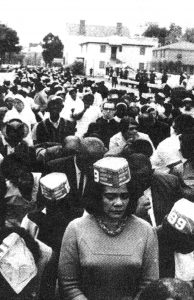


Thursday, June 14, 2018
‘Neighbor’ showcases the spirit of kindness and compassion
“Won’t You Be My Neighbor?” (2018). Cast: Interview Footage: Joanne Rogers, James Rogers, John Rogers, François Scarborough Clemmons, Yo-Yo Ma, Elizabeth Seamans, Margy Whitmer, Davis Newell, Joe Negri. Archive Footage: Fred Rogers, Robert Kennedy, Tom Snyder, Christa McAuliffe, John O. Pastore, Betty Aberlin. Director: Morgan Neville. Web site. Trailer.
Showing a little kindness goes a long way, especially to those in need of compassion, nurturing and support. This is particularly true when it comes to young ones, who often struggle with the fundamental task of trying to understand how the world works, an increasingly challenging task in an ever-more complicated reality. For 30 years, an unlikely television personality undertook that very task, giving attention, encouragement, wisdom and support to those who all too frequently went overlooked by their preoccupied, impatient and even unconcerned elders. And now the many quiet but profound accomplishments of that soft-spoken, cardigan-clad TV icon are celebrated in the endearing new documentary, “Won’t You Be My Neighbor?”
In many respects, Fred Rogers (1928-2003) was probably the last person anyone would see as a television star. By all rights, most programmers probably would have seen the gentle-mannered everyman who spoke in deliberate, measured tones as their least likely casting choice for hosting a TV program. But, given what Rogers set out to do, there was no one more suited to the job. And, through his long-running PBS series Mister Rogers’ Neighborhood, he made the most of his opportunity. With a mix of lovable puppets, a company of friendly “neighborhood residents” and even some big-name guest stars like cellist Yo-Yo Ma, all of whom engaged with the host in thoughtful conversations and sweet, charming songs, Rogers carefully crafted a program that grew from a local Pittsburgh production into a national sensation. Children’s television icon Fred Rogers, host of the PBS series Mister Rogers’ Neighborhood, on the set of his long-running show, as seen in director Morgan Neville’s endearing new documentary, “Won’t You Be My Neighbor?” Photo by Jim Judkis, courtesy of Focus Features.[/caption]
Children’s television icon Fred Rogers, host of the PBS series Mister Rogers’ Neighborhood, on the set of his long-running show, as seen in director Morgan Neville’s endearing new documentary, “Won’t You Be My Neighbor?” Photo by Jim Judkis, courtesy of Focus Features.[/caption]
Rogers, who actively sought to spread the word to younger audiences about such concepts as kindness, acceptance and understanding, had just the right mix of qualities that small children could readily and comfortably relate to. As an ordained minister, he had an approachable demeanor that enabled him to effectively convey the importance and relevance of such humane values, but he never preached nor infused his teachings with religious dogma. In many ways, he communicated to his constituency of little ones on their own level, something that made him a big hit with the preschool and kindergarten crowd.
Ironically, Rogers disliked much of what was on television, especially for children. He believed that programmers were doing a major disservice to this audience by endlessly broadcasting inane shows filled with silly, slapstick humor that comically but inherently celebrated violence, bullying, humiliation and other undesirable values. He was convinced that the medium could be used more effectively, that it could serve as a positive influence to youngsters in their formative years by presenting programs that taught valuable life lessons and encouraged them to embrace qualities that would eventually make them better adults.
In pursuing this goal, however, Rogers didn’t believe in sugarcoating everything. When the show debuted in 1968, the world was experiencing considerable turmoil, such as the Vietnam War and the assassination of Presidential hopeful Robert Kennedy, events that undoubtedly bewildered many of the nation’s youth. But, rather than shelter children from these unpleasant realities, Rogers tackled them head on, addressing them thoughtfully in ways that kids could understand. He did the same when it came to exploring such issues as divorce, illness, racial strife and death, usually by discussing the subjects in ways that stressed qualities like compassion and tolerance. The hope here was that he could impart realistic but considerate attitudes about these aspects of life, unpleasant though inescapable as they may be. Fred Rogers, host of the long-running PBS children’s series Mister Rogers’ Neighborhood, poses with one of his beloved puppets, Daniel Tiger, in the new documentary, “Won’t You Be My Neighbor?” Photo by The Fred Rogers Company, courtesy of Focus Features.[/caption]
Fred Rogers, host of the long-running PBS children’s series Mister Rogers’ Neighborhood, poses with one of his beloved puppets, Daniel Tiger, in the new documentary, “Won’t You Be My Neighbor?” Photo by The Fred Rogers Company, courtesy of Focus Features.[/caption]
In this sense, as series regular Elizabeth Seamans and producer Margy Whitmer observe in the film, Rogers was quite innovative, if not radical, in his approach. His material may have been dressed up in a pleasant, safe, accessible package, but his show’s content was far different from much of the other children’s programming of the day, something that quietly but profoundly set the program apart.
Rogers didn’t focus only on children’s issues, though; he had his share of dealings with grown-ups as well. For instance, he hosted two seasons of a documentary series called Old Friends…New Friends in which he interviewed celebrities like Milton Berle and Helen Hayes, taking an approach where he would try to engage in the same kind of thoughtful, meaningful conversation with adults that he did with his younger audiences. He also regularly appeared as himself on TV talk shows like those hosted by Tom Snyder. And, as a passionate advocate for government funding of pubic television, he testified before Congressional committees to make the case for his cause, convincingly enough to change the mind of hardened skeptic Senator John O. Pastore, who was all but ready to see the proposed subsidy summarily scrapped.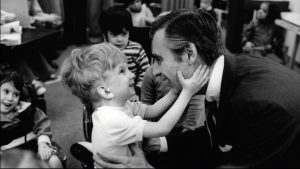 Children’s television icon Fred Rogers (right), longtime host of Mister Rogers’ Neighborhood, meets with a young disabled boy, as seen in the endearing new documentary, “Won’t You Be My Neighbor?” Photo by Jim Judkis, courtesy of Focus Features.[/caption]
Children’s television icon Fred Rogers (right), longtime host of Mister Rogers’ Neighborhood, meets with a young disabled boy, as seen in the endearing new documentary, “Won’t You Be My Neighbor?” Photo by Jim Judkis, courtesy of Focus Features.[/caption]
Through his efforts, Rogers truly was a pioneer in children’s television programming. Were it not for his vision, there may not have been the show that he created and the many others that have followed in its wake, such as Sesame Street and The Electric Company. Thanks to someone who believed in the idea that a medium as powerful as TV could indeed do better, we’ve been able to see that notion come into reality. And, given the current state of television, we could certainly use a lot more visionaries like Fred Rogers these days.
Of course, none of this would have happened were it not for Rogers’s command of the conscious creation process, the means by which we manifest the reality we experience through the power of our thoughts, beliefs and intents. Even if he had never heard of this philosophy, he certainly had a mastery of its principles, and that’s apparent in what he so successfully materialized. And, at that core of that success is the firm grasp he had on his beliefs, those metaphysical building blocks that led to the creation he produced.
As noted earlier, Rogers firmly believed that children’s television could improve upon what it was producing at the time he was breaking into the business. His faith in that belief was indeed strong, and that helped make the realization of his goal possible. Perhaps that faith in what he sought to manifest was an outgrowth of his ministerial calling, an attribute that strengthened his resolve and made the possibility of reaching his goal that much more likely. Were we to apply that same kind of conviction toward our aspirations, drawing from Rogers’s example, we all might be able to achieve more of what we seek to accomplish. Children’s television icon Fred Rogers (left), longtime host of Mister Rogers’ Neighborhood, shares a moment to cool down on a hot summer day in the neighborhood with series regular Officer Clemmons (François Scarborough Clemmons, right), as seen in director Morgan Neville’s new documentary, “Won’t You Be My Neighbor?” Photo by John Beale, courtesy of Focus Features.[/caption]
Children’s television icon Fred Rogers (left), longtime host of Mister Rogers’ Neighborhood, shares a moment to cool down on a hot summer day in the neighborhood with series regular Officer Clemmons (François Scarborough Clemmons, right), as seen in director Morgan Neville’s new documentary, “Won’t You Be My Neighbor?” Photo by John Beale, courtesy of Focus Features.[/caption]
A large part of Rogers’s success came from his ability to envision possibilities that go beyond the conventional. By considering different options and surpassing established and supposedly accepted limitations, he was able to come up with conceptions not previously thought of, let alone attempted. Those who adhered to an innately narrower view, with a much more restricted belief palette, for example, may never have been able to come up with the inventive approaches Rogers did for addressing sensitive or difficult subjects in ways that children with their less worldly ways could understand. But it happened because, on some level, Rogers believed it could be done and brought into being. Again, if we were to adopt such an outlook for ourselves, there’s no telling what we might attain.
It’s indeed fortunate that Rogers focused his efforts on childhood development. As many in the metaphysical community are well aware, we, as human beings, tend to be most open to possibilities when we’re in our youth. Unfortunately, too many inquisitive, impressionable minds get shut down early on in life through the often-coerced imposition of limiting beliefs, perspectives that prevent the flowering of their potential. Through his programming, Rogers sought to counter that regrettable practice, encouraging his young viewers to keep those minds open at a time when they’re already the most receptive to inspiring input. In a world beset by as many challenges as we face these days, we can use as many open minds as we can find. And, to that end, we can also use as many Mr. Rogers as we can find as well.
While there’s a slight tendency toward “Won’t You Be My Neighbor?” being somewhat saccharine encrusted, and despite some slightly sluggish pacing in the first 30 minutes, the film comes through successfully on all fronts, effectively delivering its contents with ample humor, surprising candor and many heartwarming moments. The archive footage featuring interviews with Rogers and footage from his shows reveal the deceptively profound approach he employed and the many sides of the protagonist, including some very different from the nice but nerdy persona for which he’s probably best known. Recent interviews with Rogers’s wife, children, friends and collaborators provide additional insights into the man and his motivations. In all, director Morgan Neville has compiled a documentary well worth your time, again revealing this filmmaker to be one of the best when it comes to this genre.
Given the pressures of today’s world, it’s easy to lose our composure and abandon our civility. Under conditions like this, we could all use some kind words and a little comforting to cope with the strife and challenges we face. And that’s where the wit and wisdom of Fred Rogers can do us all a world of good, especially if all of us ultimately hope to create a good world.
Copyright © 2018, by Brent Marchant. All rights reserved.
Monday, June 11, 2018
Check out Writers Assembled!
I'm thrilled to announce that I'm this week's Featured Author on the Member Profile feature of the Writers Assembled Facebook group. Throughout the week (Monday through Saturday), I'll be addressing questions posed by the group regarding my work, my writing process and other topics. If you're a fellow writer, a fan or someone who's interested in my work and the method to my madness, check it out!

Sunday, June 10, 2018
‘Book Club’ celebrates second chances at love
“Book Club” (2018). Cast: Diane Keaton, Jane Fonda, Candice Bergen, Mary Steenburgen, Andy Garcia, Craig T. Nelson, Don Johnson, Richard Dreyfuss, Alicia Silverstone, Katie Aselton, Wallace Shawn, Ed Begley Jr., Mircea Monroe, Joey Stromberg, Sabrina Friedman-Seitz. Director: Bill Holderman. Screenplay: Bill Holderman and Erin Simms. Web site. Trailer.
As the years pass by, it can be easy to let our lives (and ourselves) slide. Those of us who have attained a certain age may unwittingly fall into the trap of believing that the best years are behind us, that the joys of our youth and young adulthood are no longer available or take too much effort to recapture. This is especially true when it comes to our love lives. But is that really the case? It might take a little initiative to get back what’s been lost, but it is indeed possible – and worth it – as a quartet of seniors discover for themselves in the new romantic comedy, “Book Club.” Longtime friends Diane (Diane Keaton, left), Sharon (Candice Bergen, second from left), Vivian (Jane Fonda, second from right) and Carol (Mary Steenburgen, right) get together every month to enjoy great works of literature, such as E.L. James’s Fifty Shades of Grey, in the new romantic comedy, “Book Club.” Photo courtesy of Paramount Pictures.[/caption]
Longtime friends Diane (Diane Keaton, left), Sharon (Candice Bergen, second from left), Vivian (Jane Fonda, second from right) and Carol (Mary Steenburgen, right) get together every month to enjoy great works of literature, such as E.L. James’s Fifty Shades of Grey, in the new romantic comedy, “Book Club.” Photo courtesy of Paramount Pictures.[/caption]
When four friends form a book club, who thought they’d still be meeting 40 years later? But so it is with Diane (Diane Keaton), Sharon (Candice Bergen), Carol (Mary Steenburgen) and Vivian (Jane Fonda). The vibrant, spry seniors are all going strong in their lives except in one very important area – the romance department. But, then, each of them has her own challenges:
- Diane was married for decades and became the proud mother of two (Alicia Silverstone, Katie Aselton). But, with the death of her husband a year ago, she now faces a somewhat uncertain future. Her overprotective daughters want her to relocate from her home in southern California to a retirement community near them in Arizona, but she has reservations about leaving her friends behind. And, even though she’s available again, dating is the last thing on her mind, especially with her kids meddling in seemingly every aspect of her life.
- Sharon was happily married (or so she thought) for many years. But, when her husband, Tom (Ed Begley Jr.), left her for a younger woman (Mircea Monroe), Sharon’s love life came to an abrupt halt. Even though she got divorced and felt nothing but animosity toward her ex, she couldn’t get past her anger and refused to move forward, a struggle that’s been going on for 20 years. She threw herself into her work as a federal judge and never gave romance a second thought.
- As the owner of a successful upscale restaurant, Carol loves her work. She also loves her husband, Bruce (Craig T. Nelson), who recently retired. With more free time to spend with one another, she had great hopes for reinvigorating their relationship. That expectation hasn’t panned out, however, as things have turned rather humdrum, especially in the bedroom. Carol drops more than her share of hints about spicing up their love life, but Bruce is either unaware or uninterested in her advances. What’s a frisky wife to do?
- Free-spirited Vivian has always been hard to pin down, especially where relationships are concerned. As a successful hotelier, she’s been far too focused on building her career and business to think about getting involved. She even turned down a proposal from an old flame, Arthur (Don Johnson). Her attitude didn’t keep her from having a robust sex life, but she never saw herself as the marrying type. However, now that she’s getting on in years, does she still want to be on her own, unhindered but nevertheless alone?
 Diane (Diane Keaton, left), widowed after a long marriage, rediscovers the joys of dating when she meets a sexy pilot, Mitchell (Andy Garcia, right), in the new romantic comedy, “Book Club.” Photo courtesy of Paramount Pictures.[/caption]
Diane (Diane Keaton, left), widowed after a long marriage, rediscovers the joys of dating when she meets a sexy pilot, Mitchell (Andy Garcia, right), in the new romantic comedy, “Book Club.” Photo courtesy of Paramount Pictures.[/caption]Realizing these predicaments, Vivian decides to do something about it. When it’s her turn to choose a book for the club to read, she decides to shake things up by selecting Fifty Shades of Grey by E.L. James. If that saucy tale of sexual escapades doesn’t get the girls stoked up once again, she reasons, nothing will.
When Vivian announces her selection at a club meeting, her cohorts resist the idea. Given the book’s tawdry reputation and the respectable menu of titles they’ve read over the years, the other club members can’t see themselves perusing the pages of something as pulpy as the steamy best-seller. But, after they begin reading, they become unexpectedly captivated. What’s more, they find themselves inspired, prompting them to begin acting on their impulses – and their hormones – to get funky once again:
- Through a chance meeting on a flight to visit her daughters, Diane befriends a sexy pilot, Mitchell (Andy Garcia). Before long, she gets to find out just how friendly the skies can be.
- After working up the nerve to try her hand at online dating, Sharon launches into an unexpectedly frisky relationship with a tax attorney, George (Richard Dreyfuss). In no time she’s banging things other than her gavel.
- With a little trial and error, Carol finds ways to perk up her husband. Her timing isn’t always the most opportune, but she gets results that get noticed (even if they’re noticed by the wrong parties).
- And, much to her surprise, Vivian find herself on the verge of getting serious about someone – Arthur, whom she runs into unexpectedly in the lobby of her hotel. Will she rediscover what she passed up years ago?
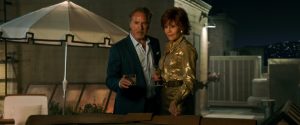 Successful hotelier Vivian (Jane Fonda, right) rekindles her romance with an old flame, Arthur (Don Johnson, left), in filmmaker Bill Holderman’s directorial debut, “Book Club.” Photo courtesy of Paramount Pictures.[/caption]
Successful hotelier Vivian (Jane Fonda, right) rekindles her romance with an old flame, Arthur (Don Johnson, left), in filmmaker Bill Holderman’s directorial debut, “Book Club.” Photo courtesy of Paramount Pictures.[/caption]So what accounts for this change? It comes down to a matter of beliefs, the stuff of which our reality is made, thanks to the conscious creation process, the means by which those metaphysical building blocks are transformed from intangible ideas into manifested conceptions. And, specifically, it’s the changes in the women’s beliefs that bring out their new realities. Several factors figure into this.
For starters, Diane, Sharon, Carol and Vivian all realize that they’re not stuck with their circumstances; they have the powers of choice and free will at their disposal, and, should they opt to make use of them, they can re-create their existences in any way they like. However, they have to take the first step to make that happen. This can come about in a variety of ways, but, as with most of us, they must first grow so dissatisfied with their realities that they desire something new to take their place. But, also like many of us, they need some kind of catalytic inspiration to get their visionary juices flowing, and that’s where E.L. James comes in.
To bring about the change they want, the women must address the specific beliefs that are keeping them locked in place. Essentially they need to move beyond whatever is inhibiting them. Some may seem them, kindly, as apprehensions; others may view them, somewhat less delicately, as excuses. But, no matter what anyone calls them, at their heart, the beliefs that are holding them back are fundamentally limitations, and it’s those limitations that must be overcome if they want something new in their lives.
 Restaurateur Carol (Mary Steenburgen, left) looks for ways to spice up her love life with her recently retired husband, Bruce (Craig T. Nelson, right), in the new romantic comedy, “Book Club.” Photo courtesy of Paramount Pictures.[/caption]
Restaurateur Carol (Mary Steenburgen, left) looks for ways to spice up her love life with her recently retired husband, Bruce (Craig T. Nelson, right), in the new romantic comedy, “Book Club.” Photo courtesy of Paramount Pictures.[/caption]Each of the women has her own limitations to get past, and addressing the specific self-imposed roadblocks they’ve set up for themselves is crucial to moving beyond them:
- Diane has more than her share of doubts – doubts about herself, her future, what she wants out of life and, most of all, a romantic life. If she can’t get past this, nothing will materialize, because our divine collaborator in the conscious creation process is unable to accommodate such conflicting intentions. After all, how can an entity capable of manifesting any wish do so if we doubt its ability to comply? It’s like saying “I want it, but I don’t believe you can give it to me” simultaneously.
- Sharon’s plagued by a combination of doubt and fear, a double whammy when it comes to undercutting the effectiveness of the conscious creation process. Since her marriage ended, she doubts that she’ll find happiness again, especially since she’s now unsure that she ever found it the first time around. This makes her reluctant, if not downright fearful, of trying again, because she doesn’t want to repeat what she sees as a mistake. However, if she also realizes what she’s learned from her first experience, she can move forward by putting beliefs into place that rule out those unfortunate possibilities from manifesting a second time.
- Even though Carol hopes for more fun-filled times now that Bruce is retired, on a deeper level, what’s really driving her motivations is a fear of losing the happiness she enjoys with her husband – if not the marriage itself. To compensate for that, she believes she needs to try extra hard to hold on to what she’s got. That may appear noble and committed, but it’s underpinned by a sense of desperation, a fear-driven attitude if there ever were one. This is a practice sometimes referred to as pushing the Universe, a practice where we try cajoling our divine collaborator into cooperation (or, more precisely, submission). Unfortunately, since fear is at the heart of this practice, it seldom works, bringing us distorted results, as Carol routinely finds out. To attain the outcome she wants, she needs to lose the fear and adopt beliefs aimed at bringing her what she wants without having to employ desperation in doing so.
- Fear is also at the heart of Vivian’s issues, specifically a fear of losing her sense of independence. She enjoys being her own person and is not anxious to compromise herself on this point, even if it means intentionally and steadfastly remaining single. But are independence and being partnered mutually exclusive? Perhaps it’s possible to embrace beliefs that accommodate both. In fact, maybe there are men out there who are attracted to women who are assertive, strong-willed and in charge of their destinies. Maybe Vivian should try implementing beliefs that embody such notions; she might be very pleasantly surprised by the results.
Themes like these have become quite common in movies these days, but they seem especially pertinent for this band of characters (and the demographic to which this movie appeals). As we age, unfortunately, we tend to grow less flexible in out outlooks, a perspective that can significantly inhibit our enjoyment of life and our prospects for the future. That’s important to bear in mind for seniors. They must ask themselves, “With the clock running out, how long are we going to wait?” In that light, then, this film offers those who are a little on in years a potent cautionary tale, especially for those who’ve lost their ambition or expectations of anything better coming along. By simply asking “Why not?” rather than perpetually defaulting to “Why should I?”, they may find some exceedingly pleasant surprises in store.
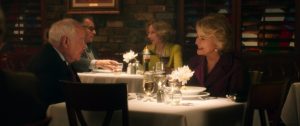 Divorcee Sharon (Candice Bergen, right) takes a chance on romance with George (Richard Dreyfuss, left) thanks to an online dating site in “Book Club.” Photo courtesy of Paramount Pictures.[/caption]
Divorcee Sharon (Candice Bergen, right) takes a chance on romance with George (Richard Dreyfuss, left) thanks to an online dating site in “Book Club.” Photo courtesy of Paramount Pictures.[/caption]In a world that worships youthfulness and all too readily shuttles the mature set out to pasture, it’s refreshing to see a story like this. It celebrates aging and demonstrates that it needn’t be looked upon as a time of life characterized by bland food, mahjong tournaments and lonely evenings in front of the TV with the volume turned up high. It truly can mean a fresh start, one full of vibrancy, engagement and maybe even a little naughty behavior. Indeed, this film shows that it’s never too late to have fun and enjoy life, no matter what ad agencies, social media and allegedly in-the-know trend influencers might say.
Put simply, “Book Club” is a real joy. What a treat it is to see a quartet of veteran performers doing what they do best and quite obviously enjoying themselves at it! This light, frothy, albeit somewhat predictable chick flick for the mature set clearly has its heart in the right place and hits the right notes most of the time. Granted, some of the jokes don’t land as solidly as they could, particularly in the first 30 minutes, and some of the humor is a little on the trite side. But, all things considered, this is still one fine diversion, full of fun, full of spirit and full of life, especially for those who can appreciate where its protagonists are coming from and are in need of a few good laughs.
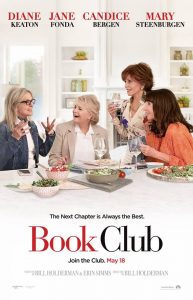
As the years pile up, it’s all too convenient – and perhaps even a little tempting – to grow complacent and settled, stuck in a rut of our own making. We can slip into it so casually that we might not even realize we’ve done so until we’re in the throes of it. But the examples in this film show what it means to come alive again, to rejoin those who enjoy life. And to think it can all start with something as simple as picking up a book – or watching a movie.
Copyright © 2018, by Brent Marchant. All rights reserved.
Thursday, June 7, 2018
‘First Reformed’ assesses our choices and their results
“First Reformed” (2018). Cast: Ethan Hawke, Amanda Seyfried, Cedric Kyles, Victoria Hill, Philip Ettinger, Michael Gaston, Bill Hoag, Frank Rodriguez. Director: Paul Schrader. Screenplay: Paul Schrader. Web site. Trailer.
The weight of the world is quite a load for anyone to carry, even those who believe they’re best equipped to do so. Holding up under such circumstances can easily be more than one can bear, but some take up the challenge anyway. Why? That’s a key question for a beleaguered protagonist in the gripping new drama, “First Reformed.”
Pastor Ernst Toller (Ethan Hawke) is, somewhat ironically, a troubled soul. As a former military academy chaplain who has suffered a number of personal tragedies and a crisis of conscience, he’s been assigned to what would seem to be a soothing, less stressful post – overseeing the operations of the First Reformed Church, a historic parish in Upstate New York. Established in 1767, his church has a long and celebrated history, but it has fallen on hard times in recent years. The parish has become more of a tourist destination than an active fellowship, and its paltry congregation is too small to support the ongoing monetary needs of the church. To stay afloat, First Reformed’s finances are propped up by sales of souvenirs and the generous bankrolling of the nearby Abundant Life megachurch, a facility run by one of Toller’s few friends and confidantes, the charismatic Pastor Joel Jeffers (Cedric Kyles, a.k.a. Cedric the Entertainer). Toller sees the necessity of these measures, but he dislikes the commercialism of a church hawking tee shirts, and he’s uncomfortable continually accepting charity.
Pastor Toller’s woes don’t end with his past and the troubles of his parish, either. His health has been giving him problems, and he’s slowly losing a battle with the bottle. He’s also uneasy with the fallout from his brief romance with Esther (Victoria Hill), a kind but incredibly clingy parishioner. Their affair apparently ended awkwardly, and she’s unwilling to let go of it. All told, it’s quite a full plate. Pastor Ernst Toller (Ethan Hawke) wrestles with a bundle of personal issues in the intense new drama, “First Reformed.” Photo courtesy of A24.[/caption]
Pastor Ernst Toller (Ethan Hawke) wrestles with a bundle of personal issues in the intense new drama, “First Reformed.” Photo courtesy of A24.[/caption]
As a scholarly, thoughtful sort, Toller spends many hours in study, particularly the works of authors like monk Thomas Merton, looking for the answers that perpetually seem to elude him. He also keeps a journal to sort out his thoughts, passages of which are read as voiceover narrations. However, these attempts at grounding himself offer little solace or insight, arguably making things even worse. As time passes, he seems to sink further and further into the depths of despair, both for himself and in his perspectives on the state of the world.
Those feelings become exacerbated when Toller is approached by one of the members of his congregation, Mary (Amanda Seyfriend), who asks him if he’d be willing to help counsel her husband, Michael (Philip Ettinger). As a somewhat overzealous environmental activist who was recently released from a Canadian prison for compassionate reasons (Mary is pregnant), Michael is severely depressed about the future of the planet and has serious reservations about bringing a child into a world whose ecological prospects look increasingly bleak. He believes that ending the pregnancy could be the best course.
Being the compassionate soul that he is, and despite the weight of his own personal challenges, Pastor Toller agrees to speak with Michael. He offers what uplifting guidance he can, drawing from both scripture and personal experience, but he finds that the arguments Michael raises to defend his perspective are difficult to counter. In fact, the Reverend even begins to sympathize with his troubled parishioner’s position. He comes to see the perils associated with environmental degradation, and it reminds him of Biblical passages that call upon humanity to be dutiful stewards of the earth, caretakers of God’s creation, a task at which he, like Michael, increasingly believes we’re failing – and miserably.
While the Pastor’s emerging environmental sensibility only adds to his despondent state, he nevertheless appears to be going through a personal evolution, one in which he seems more willing to address practical secular matters rather than staying trapped in the realm of purely lofty philosophical issues. He takes steps in which he rejoins the world. And, even though his focus is almost exclusively on the negative, his evolving attitude nevertheless represents a fundamental change in outlook, one that increasingly prompts him to take a stand by taking decisive action, especially where the environment is concerned. That urge is further energized when he learns that one of the largest donors to Abundant Life (and, by extension, to First Reformed) is also one of the worst polluters on the planet.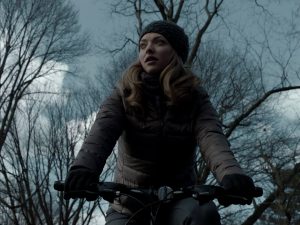 Mary (Amanda Seyfried), a young mother-to-be, seeks counseling for her troubled husband from an equally troubled pastor in writer-director Paul Schrader’s gripping new drama, “First Reformed.” Photo courtesy of A24.[/caption]
Mary (Amanda Seyfried), a young mother-to-be, seeks counseling for her troubled husband from an equally troubled pastor in writer-director Paul Schrader’s gripping new drama, “First Reformed.” Photo courtesy of A24.[/caption]
Others can see the pain he’s going through. Esther offers him comfort that he routinely rejects. Pastor Jeffers tries counseling him as well, observing that Pastor Toller spends “too much time in the garden,” suggesting that he’s trying to take on even more of the weight of the world than Jesus did. Even the joy that the upcoming 250th anniversary celebration of First Reformed’s consecration should engender does little to raise his spirits. Those who genuinely care about his well-being try to convince him that there’s nothing wrong with being happy in life and that actively seeking it out is part of our fundamental human nature, but these suggestions tend to fall on deaf ears. The only one who seems able to successfully reach out to the troubled pastor is Mary. But is her encouragement enough? And will he get the message?
So why is the good Reverend so full of angst, misery and quiet desperation? Sadly it’s because he’s choosing to be. Given his personal experience and the conditions around him, he’s focusing on them to the exclusion of other possibilities, which are just as available, even though he’s opting not to see them. By taking such a narrow view of things, he comes to believe that this is how reality is and operates, and the more stock he places in those beliefs, the more they become reinforced, and ultimately entrenched, in defining the character of his existence. Elements that typify this outlook become manifest and frame the nature of his world. And it unfolds in this way, because that’s how the conscious creation process functions, the means by which our reality comes into being through the power of our thoughts, beliefs and intents.
Of course, Pastor Toller needn’t choose this path if he doesn’t want to. Because we’re each capable of choosing from an infinite range of belief possibilities at any given moment, he could just as readily pursue a different course by embracing different belief options. On some level, he even seems to sense those possibilities, as evidenced by the questioning he raises through his journaling and studies. But, if switching paths is so easy, why doesn’t he do it?
That’s a good question. As with any of us, only we truly know why we adopt the belief stances we do (and sometimes the reasons elude even us). In many instances, we choose to follow certain paths in order to learn various life lessons, for better or worse, and the only way to experience them is to intentionally manifest them for ourselves, regardless of their nature. But that naturally begs the question, why would we want to learn lessons like those Toller is experiencing?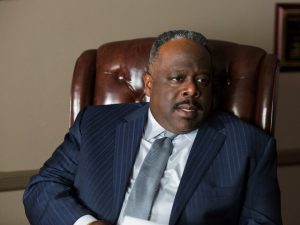 Pastor Joel Jeffers (Cedric Kyles, a.k.a. Cedric the Entertainer), the charismatic head of a megachurch, tries to offer help to a troubled peer in “First Reformed.” Photo courtesy of A24.[/caption]
Pastor Joel Jeffers (Cedric Kyles, a.k.a. Cedric the Entertainer), the charismatic head of a megachurch, tries to offer help to a troubled peer in “First Reformed.” Photo courtesy of A24.[/caption]
Again, the reasons (and the beliefs behind them) are each our own. But perhaps we need to go through certain experiences purposely to see and appreciate the other side of the coin. In Pastor Toller’s case, for instance, perhaps he needs to immerse himself in despair as a means to learn how awful it can be as a prelude to experiencing its opposite, joy. For him, maybe this is possible only after having mired himself in sadness for so long that he can no longer tolerate it and wants something else – and something better. However, perhaps the only way he can come to realize that is to create the despair first, giving himself something as a basis of comparison to the elation that’s available to him whenever he finally chooses to embrace it. Admittedly that’s a rather hard way to find out, but, for some of us, learning the hard way may be the only way we can get the lesson.
In some ways, Toller’s choice of vocation lends itself to such an experience. While serving in this capacity can have its moments of joy, being a pastor often involves offering comfort to those in pain, a practice that exposes the caregiver directly to the suffering of others. Constant exposure to such conditions can continually reinforce an outlook like the one he holds. Is it any wonder that it would begin to wear on him, convincing him that this is simply how existence is? It would seem that it’s got to get to someone at some point, especially for someone as high-minded and idealistic as he is.
One could argue that there’s genuine nobility in taking on the role of freely offering compassion to the downtrodden, and such a contention would indeed have merit. Toller certainly seems to abide by such principles, truly caring for those to whom he ministers, no matter how small his congregation. But, given his high standards and ready willingness to give of himself to others, this practice can become wearing, no matter how good his intentions. Expecting perfection and splendor in a reality brought into being by the kinds of beliefs Toller holds can lead to exasperation, perhaps even the pursuit of desperate measures, including those that many would find objectionable and out of character.
In this regard, many viewers and critics have astutely observed that there are many parallels between the narrative of this film and one of writer-director Paul Schrader’s previous pictures, “Taxi Driver” (1976), for which he wrote the screenplay from which filmmaker Martin Scorsese directed. Even though there are a number of fundamental differences between Toller and Travis Bickle (Robert DeNiro), the protagonist in “Taxi Driver,” there are also a number of uncanny similarities in their outlooks, actions and circumstances. Indeed, it’s difficult to manifest a perfect world in one in which the beliefs creating it are full of imperfections, a situation that can lead to frustration and, eventually, desperation.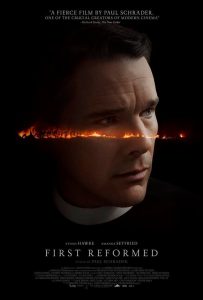
One can only hope that Toller finds the peace for himself that he so compassionately attempts to offer others. But, as has been often said, “Charity begins at home,” and the good pastor should consider taking care of himself with the same principles of empathy and concern that he shows his parishioners. By operating from a position of personal strength and a joyful perspective, he may find a very different reality emerging around him, something that will benefit him and those to whom he attends.
There’s quite obviously much to consider in this offering. “First Reformed” presents a captivating examination of the difference between being in the world or apart from it, regardless of whether we’re devoted spiritual practitioners or principally secular beings. It explores the meaning of despair, the search for happiness, and the need to strike a balance between our sacred and worldly lives. It probes our prevailing core outlooks, whether we choose to see the glass as half full or half empty (or, in even more extreme terms, completely full or completely empty). And, of course, it asks us to examine our faith, not only in our divine connection, but also that of it in ourselves and in our fellow man.
While some elements of the picture are a little dragged out (likely intentionally to convey to viewers the burden the protagonist is saddled with), much of the film sizzles with an underlying intensity that you can feel in your gut as the story unfolds. As Toller’s story plays out, we can empathize with the dark night of the soul issues he wrestles with, so much so that it almost feels as if we’re being dragged along for the ride (and a rather uncomfortable one at that). With what is undoubtedly Ethan Hawke’s best screen performance, a surprisingly strong portrayal by Cedric Kyles in a dramatic role and phenomenal atmospheric cinematography, writer-director Paul Schrader has put together a film that gives us all much to contemplate, as well as emotional impressions, both haunting and uplifting, that will stay with us long after we leave the theater. This is handily one of the best releases of 2018 thus far.
When faced with the kinds of choices posed in this film, we’re reminded of the importance of our power of free will. It’s one of our most precious birthrights. Yet it’s of little value to us if we fail to make use of it. Retaining sight of it is crucial, especially at those times when we face moments of personal crisis. We can choose to languish in the depths of despair or to aspire to something more elevated. Let’s hope we have the insight to see the difference and make the right choice.
Copyright © 2018, by Brent Marchant. All rights reserved.
Wednesday, June 6, 2018
‘Filmworker’ celebrates the beauty of creative vision
“Filmworker” (2017 production, 2018 release). Cast: Interview Footage: Leon Vitali, Ryan O’Neal, Matthew Modine, R. Lee Ermey, Danny Lloyd, Stellan Skarsgård, Marie Richardson, Tim Colceri, Pernilla August, Julian Senior, Lisa Leone. Archive/Feature Film Footage: Stanley Kubrick, Malcolm MacDowell, Keir Dullea, Jack Nicholson, Shelley Duvall, Marisa Berenson, Vincent D’Onofrio, Tom Cruise. Director: Tony Zierra. Web site. Trailer.
Director Stanley Kubrick is arguably one of the most brilliant filmmakers who ever lived. Though he wasn’t particularly prolific and his productions came more sporadically in his later years, he nevertheless was responsible for such classics as “Dr. Strangelove or: How I Learned to Stop Worrying and Love the Bomb” (1964), “A Clockwork Orange” (1971), “Barry Lyndon” (1975), “The Shining” (1980), “Full Metal Jacket” (1987), “Eyes Wide Shut” (1999) and his groundbreaking masterpiece, “2001: A Space Odyssey” (1968), which was recently re-released in a beautifully restored, 50th anniversary edition. But, as skilled an auteur as Kubrick was, much of his repertoire never would have come into being in its magnificence were it not for the efforts of his right-hand man, a tireless jack of all trades who proved to be the man behind the man, the subject of the fascinating new documentary, “Filmworker.”
In 1968, aspiring English actor Leon Vitali went to see Kubrick’s “2001: A Space Odyssey”; he was captivated. Three years later, he screened “A Clockwork Orange”; he was captivated again. From that point forward, Vitali vowed that one day he would somehow join forces with the iconic filmmaker. And, after several years of journeyman acting work in British television shows and several films, he auditioned for the part of Lord Bullingdon in Kubrick’s “Barry Lyndon,” a role he landed, much to the young actor’s surprise.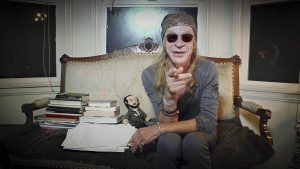 With a likeness of his collaborator, director Stanley Kubrick, at his side, longtime production assistant Leon Vitali explains the many roles he played in helping bring the filmmaker’s pictures to life in the riveting new documentary, “Filmworker.” Photo courtesy of Kino Lorber.[/caption]
With a likeness of his collaborator, director Stanley Kubrick, at his side, longtime production assistant Leon Vitali explains the many roles he played in helping bring the filmmaker’s pictures to life in the riveting new documentary, “Filmworker.” Photo courtesy of Kino Lorber.[/caption]
While on the set of “Lyndon,” Vitali became fascinated with all of the equipment, technology and expertise that went into the making of a film of this magnitude – so much so that he wanted to learn more about it. He asked Kubrick if he could watch the film editing process, perhaps become involved in it, even for no pay, just so he could learn the ropes, a request to which the director agreed. And, once Vitali got a taste of the behind-the-scenes work, he was hooked. He was convinced that he wanted to change tracks, leaving acting behind for the technical side of filmmaking, a bold move for someone whose onscreen career was just beginning to crest.
After gaining some valuable experience on the Swedish-Irish production “Terror of Frankenstein” (1977), Vitali approached Kubrick to see if there was a place for him on the director’s upcoming new production, “The Shining.” Again, much to Vitali’s surprise, Kubrick said yes, assigning him the crucially important task of casting a child actor to play Danny, one of the picture’s principal characters. After screening more than 4,000 hopefuls, Vitali successfully cast unknown Danny Lloyd to play the part, a decision that pleased Kubrick. With that accomplishment, Vitali fell into the good graces of the director, becoming his personal assistant, a role he would play for years to come.
Over the years, Vitali would work on Kubrick’s subsequent films, “Full Metal Jacket” and “Eyes Wide Shut.” And, with the rise of home entertainment viewing options in the 1980s, he would also play in an important role in the conversion and restoration work involved in readying Kubrick’s early pictures for videotape adaptation. In all of these projects, this included not only the English language editions with which most viewers are familiar, but also all of the many foreign language versions released around the world, an immense project given the scope of distribution involved. As director Stanley Kubrick’s personal assistant, Leon Vitali (center) did everything from checking the color of the film to playing small onscreen roles, as in this scene from the director’s final picture, “Eyes Wide Shut” (1999), as seen in the new documentary, “Filmworker.” Photo courtesy of Kino Lorber.[/caption]
As director Stanley Kubrick’s personal assistant, Leon Vitali (center) did everything from checking the color of the film to playing small onscreen roles, as in this scene from the director’s final picture, “Eyes Wide Shut” (1999), as seen in the new documentary, “Filmworker.” Photo courtesy of Kino Lorber.[/caption]
In doing this work, Vitali did whatever Kubrick asked of him, which often involved tasks in which he had no experience. Vitali would wonder how he could get them done and even expressed his hesitation to his boss. But, on some level, Kubrick knew Vitali was up to the challenge. He saw talents in his assistant that he didn’t recognize. In his encouragement, Kubrick would simply tell him, “You know how” or “You’ll figure it out.” And, for his part, Vitali always did.
Vitali’s tasks covered many areas, including everything from checking the color of the film to reviewing the marketing materials to even appearing onscreen in small roles and as an extra, as he did in “Eyes Wide Shut.” The demands were sometimes great, given the volume of work and Kubrick’s relentless penchant for perfectionism in all he did (and in all he expected from his production crews). Nevertheless, Vitali always rose to the occasion.
Some might wonder why someone would be so willing to give so much of oneself under circumstances such as this. As Vitali explains, Kubrick could be quite kind and generous, but he could also be an authoritarian taskmaster. However, considering what resulted from their collaborative efforts, Vitali has no regrets. His many contributions have gone into the creation and preservation of one of filmdom’s greatest legacies. And, through “Filmworker,” director Tony Zierra has finally given Vitali his due, at last recognizing the unsung part he has played in bringing these movies to life.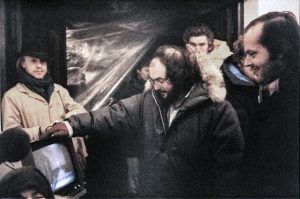 Production assistant Leon Vitali (left) assists director Stanley Kubrick (center) and actor Jack Nicholson (right) during the shooting of “The Shining” (1980), as seen in director Tony Zierra’s new documentary, “Filmworker.” Photo courtesy of Kino Lorber.[/caption]
Production assistant Leon Vitali (left) assists director Stanley Kubrick (center) and actor Jack Nicholson (right) during the shooting of “The Shining” (1980), as seen in director Tony Zierra’s new documentary, “Filmworker.” Photo courtesy of Kino Lorber.[/caption]
In watching this film, viewers have an opportunity to learn what it means to be part of something great, to participate in enlivening the creative vision of a master. The sense of loyalty, dedication and sacrifice that went into this work is abundantly apparent, clearly illustrating the protagonist’s passion for the work and in realizing the finished result. Anyone who has ever undertaken any effort of a tremendous magnitude can certainly appreciate what Vitali went through – and the fulfillment that comes through when the work is successfully accomplished.
In this regard, Vitali understood and respected the beauty of the creative process and what it’s capable of yielding. But that process never achieves fulfillment without the participation of those who bring its creations into being, and that’s where the practice of conscious creation comes into play, the means by which our reality is manifested – in all its aspects – through the power of our thoughts, beliefs and intents. And this is where Vitali’s beliefs take center stage.
As someone who appreciated the possible from a creative standpoint, Vitali put the required beliefs into place to flesh out such conceptions. Even if he wasn’t aware of the practice of conscious creation or aware of the relevant intents he was nurturing to activate it, his results nevertheless speak for themselves, demonstrating his obvious command of these capabilities.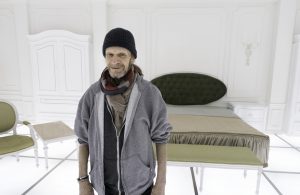 On the set of Stanley Kubrick’s iconic masterpiece “2001: A Space Odyssey” (1968), the director’s personal assistant, Leon Vitali, has long played a role in the preservation of the filmmaker’s cinematic library, including this groundbreaking work, as explained in the captivating new documentary, “Filmworker.” Photo courtesy of Kino Lorber.[/caption]
On the set of Stanley Kubrick’s iconic masterpiece “2001: A Space Odyssey” (1968), the director’s personal assistant, Leon Vitali, has long played a role in the preservation of the filmmaker’s cinematic library, including this groundbreaking work, as explained in the captivating new documentary, “Filmworker.” Photo courtesy of Kino Lorber.[/caption]
Of course, Kubrick had a little part of his own to play in this process, conceiving of the ultimate vision he sought to achieve. But the fulfillment of that vision depended heavily on his collaborator’s participation. This partnership, where both participants had the right beliefs in place to attain materialization of the sought-after result, thus represents a prime of example of co-creation, where joint efforts produce the desired mutually manifested outcome.
It’s interesting to note, as discussed above, that Kubrick knew Vitali was capable of accomplishing tasks that he didn’t think he could. On some level, the director had to have sensed his collaborator’s capabilities and the underlying beliefs that supported them, even if Vitali didn’t recognize them himself. This is the power of intuition at work, and Kubrick obviously made effective use of it in identifying Vitali’s latent skills and encouraging his assistant in bring them to the surface. By doing this, Kubrick got results he wanted and enlightened Vitali to aspects of himself of which he was unaware, thereby broadening his palette of aptitude and his potential as both an artist and conscious creation practitioner.
Such awareness showed Vitali that there was more to him than meets the eye. With the revelation of these additional aspects of himself, it helped to draw out Vitali’s multidimensional self, something that characterizes all of us but that most of us don’t recognize. But embracing this part of our being is crucial to our personal and creative development, for it helps us to grow and become more than we are – or that we think we’re capable of. It enables us to surpass constricting limitations and blossom as the full-flowered individuals we can be. With the emergence of Vitali’s multidimensional self, unexplored elements of his true self were able to come forth and manifest all that he accomplished. And, given what he ultimately achieved, film buffs should be ever grateful for his efforts – and the beliefs that made everything possible.
“Filmworker” offers viewers a fascinating look at a fascinating collaboration, with ample behind-the-scenes archive production footage and numerous clips from the films in question. Intercut with this material are interview segments featuring Vitali, fellow production crew members, film industry executives, behind-the-scene peers and numerous actors from several of Kubrick’s films (Ryan O’Neal (“Barry Lyndon”), Danny Lloyd (“The Shining”), Matthew Modine, R. Lee Ermey, Tim Colceri (“Full Metal Jacket”), Marie Richardson (“Eyes Wide Shut”)). The archive and film clip segments feature a variety of luminaries as well, including Kubrick and actors Keir Dullea, Malcolm MacDowell, Marisa Berenson, Jack Nicholson, Shelley Duvall, Vincent D’Onofrio, and Tom Cruise. These elements combine to create a moving and riveting documentary that’s sure to have widespread appeal but will utterly enthrall film buffs and fans of Kubrick’s work.
Leon Vitali may not be a household name, but his contributions to the world of film are incalculable. This film attempts to make up for that long-ignored contribution, showing the impact one man had on a treasure trove of celluloid classics. Movie fans the world over should be grateful for his efforts, and perhaps the best way they can honor him is by going to see this film. You won’t regret it.
Copyright © 2018, by Brent Marchant. All rights reserved.
